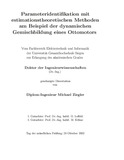Citation link:
https://nbn-resolving.org/urn:nbn:de:hbz:467-151| DC Field | Value | Language |
|---|---|---|
| dc.contributor.author | Ziegler, Michael | - |
| dc.date.accessioned | 2019-09-02T09:53:03Z | - |
| dc.date.available | 2005-09-16T12:12:12Z | - |
| dc.date.available | 2019-09-02T09:53:03Z | - |
| dc.date.issued | 2002 | - |
| dc.description.abstract | Der Einsatz dynamischer Modelle mit physikalischem Systemwissen zur Darstellung des Systemverhaltens setzt sich zunehmend bei der Entwicklung neuer Steuerungs- und Regelungskonzepte füur Verbrennungskraftmaschinen durch. In der Bestimmung der unbekannten Modellparameter liegt ein nicht unerheblicher Aufwand für den Entwicklungsingenieur. Durch eine Automatisierung der Bestimmung der unbekannten Parameter der dynamischen Modelle kann der Entwicklungsingenieur unterstützt und der Entwicklungsprozeß optimiert werden. Aus diesem Grund verfolgt die Arbeit das Ziel, eine geschlossene Darstellung estimationstheoretischen Verfahren für die Parameteridentifikation linearer und nichtlinearer Modelle zu liefern und deren Leistungsfähigkeit für eine automatisierte Parameteridentifikation aufzuzeigen. Am Beispiel der dynamischen Gemischbildung eines Ottomotors sind reine Parameterschätzverfahren und Parameter- und Zustandsschätzverfahren untersucht worden. Bei den reinen Parameterschätzverfahren werden die Verfahren Recursive Least-Square und Maximum-Likelihood sowie ein Kalman-Filter untersucht. Zur gleichzeitigen Parameter- und Zustandsschätzung sind ein Extended Kalman-Filter und ein adaptives Kalman-Filter mit überlagertem Ansatz nach Maximum-Likelihood verwendet worden. | de |
| dc.description.abstract | The need for dynamic models with physical system knowledge is steadily increasing with the development of new control concepts of combustion engines. The identification of the unknown parameters results in a not insignificant additional workload for the development engineer. Therefore, the automation of the identification supports the development engineer and optimizes the development process. The goal of this thesis is to provide a complete presentation of estimation methods for the parameter identification of linear and nonlinear models and to show the power of an automated parameter identification procedure. Pure parameter estimation methods and combined parameter and state estimation methods are examined with the example of the dynamic air and fuel ratio of a gasoline combustion engine. The parameter estimation methods tested are the Recursive Least Square, the Maximum Likelihood and the Kalman Filter. The Extended Kalman Filter and an adapted Kalman Filter with an additional Maximum Likelihood approach are used for the simultaneous parameter and state estimation methods. | en |
| dc.identifier.uri | https://dspace.ub.uni-siegen.de/handle/ubsi/15 | - |
| dc.identifier.urn | urn:nbn:de:hbz:467-151 | - |
| dc.language.iso | de | de |
| dc.rights.uri | https://dspace.ub.uni-siegen.de/static/license.txt | de |
| dc.subject.ddc | 620 Ingenieurwissenschaften und Maschinenbau | de |
| dc.subject.other | Otto engine | en |
| dc.subject.other | dynamic carburetion | en |
| dc.subject.other | parameter identification | en |
| dc.subject.other | Kalman filters | en |
| dc.title | Parameteridentifikation mit estimationstheoretischen Methoden am Beispiel der dynamischen Gemischbildung eines Ottomotors | de |
| dc.type | Doctoral Thesis | de |
| item.fulltext | With Fulltext | - |
| ubsi.date.accepted | 2002-10-27 | - |
| ubsi.publication.affiliation | Fachbereich 12, Elektrotechnik und Informatik | de |
| ubsi.subject.ghbs | XNT | - |
| ubsi.type.version | publishedVersion | de |
| Appears in Collections: | Hochschulschriften | |
Files in This Item:
| File | Description | Size | Format | |
|---|---|---|---|---|
| ziegler.pdf | 2.02 MB | Adobe PDF |  View/Open |
This item is protected by original copyright |
Page view(s)
482
checked on Nov 25, 2024
Download(s)
268
checked on Nov 25, 2024
Google ScholarTM
Check
Items in DSpace are protected by copyright, with all rights reserved, unless otherwise indicated.

